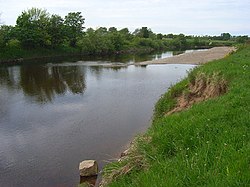Battle of Solway Moss
| date | November 24, 1542 |
|---|---|
| place | Solway Moss |
| output | English victory |
| Parties to the conflict | |
|---|---|
| Commander | |
| Troop strength | |
| approx. 18,000 | 3,000 |
| losses | |
|
about 20 in the battle |
low |
The Battle of Solway Moss took place on November 24, 1542. On the border between the two kingdoms, English and Scottish troops clashed in an area called Solway Moss near the English side of the River Esk . The battle ended after a short skirmish with the English victory and a fleeing, dissolving Scottish army.
prehistory
When Henry VIII broke with the Catholic Church, he asked his nephew Jacob V to do the same. Jakob not only ignored his uncle's request, but also refused Heinrich to attend a specially arranged meeting in York .
The offended King Henry reacted very angry and sent an English army north to invade Scotland. In retaliation for the massive British incursion, Robert, 4th Lord Maxwell and Warden of the West March , was entrusted by Jacob with the task of raising an army.
The battle
Oliver Sinclair de Pitcairnis was a personal favorite of Jacob V and intended as a commander for the campaign against the invaders. However, because Sinclair's arrival was delayed, Robert Maxwell insisted on command, even though he was not officially designated for it. The other Scottish troop leaders also refused to recognize Maxwell, which later had a very unfavorable effect on a uniform Scottish command structure in the battle.
On November 24, 1542, the Scottish army, about 18,000 men strong, crossed the English border and almost immediately encountered the 3,000-strong English army under the command of Sir Thomas Wharton , which had already awaited the enemy near Solway Moss.
The battle was poorly coordinated from the Scottish side and must be described more as a tumult. After the first encounter with the English cavalry at Akeshawsill (now Oakshawhill), the Scots had to retreat quickly and disorderly towards Arthuret Howes . They found themselves cooped up between the river and the swamp, and after a brief fierce battle they also lost their field artillery consisting of ten cannons to the English cavalry. They were finally stopped at the sandy ford near the Arthuret mill dam .
The English commander Thomas Wharton and his adjutant William Musgrove then reported on the battle. Thomas Wharton described it as "the Scots attack between the Esk and Lyne rivers". William Musgrove reported that Maxwell and a small remnant of Scottish nobles fought valiantly after they were forced to dismount their horses on the banks of the Esk.
consequences
Jacob V had stayed in Lochmaben and was not present at the battle. He returned to Falkland Palace ill , died two weeks later, leaving behind his six-day-old daughter Maria . On his deathbed he is said to have mourned the loss of his banner and the capture of Oliver Sinclair.
The losses in the fight were estimated at 7 Englishmen and 20 Scots, but several hundred Scots are said to have drowned in the river and bog. Over 1,200 Scots were captured, including many nobles such as Oliver Sinclair, the Earls of Cassillis, Glencairn and Maxwell, Lord Gray and the Stewart of Rosyth.
The higher Scottish aristocrats were allowed to return to their homeland, provided they could provide an adequate hostage or an English nobleman vouched for them. The other prisoners were first brought to Newcastle upon Tyne and appointed caretakers of their lands. Later they were brought to the court of Henry VIII, who treated them well and even gave them gifts to make them "England-friendly".
Most of the prisoners were also able to return to their homes in the following years for a ransom payment. Modern historians assume, however, that this behavior did not affect Henry VIII's policies or the decision of the Scottish nobles to reject the Greenwich Peace Treaty in December 1543.
The battlefield today
The battlefield is registered with English Heritage and is currently under archaeological research for protection and preservation under the Scottish Historical Environment Policy of 2009 by Historic Scotland .
literature
- Gervase Phillips: The Anglo-Scots Wars, 1513-1550: A Military History (Warfare in History) . Boydell Press, Woodbridge 1999, ISBN 0-85115-746-7 .
- Joseph Bain: The Hamilton papers. Letters and papers illustrating the political relations of England and Scotland in the XVIth century . Vol. IHM General Register House, Edinburgh 1890 ( online at archive.org [accessed 23 September 2014]).
Individual evidence
- ↑ Battle of Solway Moss 24th November 1542. UK Battlefields Trust, accessed September 23, 2014 .
- ↑ Phillips, 1999. p. 150
- ↑ Phillips, 1999. p. 151
- ↑ The Hamilton papers , pp. 307f.
- ↑ The Hamilton papers , p. 318
- ↑ The Hamilton papers , p. 338
- ↑ Phillips, 1999. p. 153
- ↑ Merriman, Marcus: The Rough Wooings . Tuckwell, 2000, pp. 81f.
Coordinates: 55 ° 0 ′ 40.4 ″ N , 3 ° 1 ′ 32.7 ″ W.
